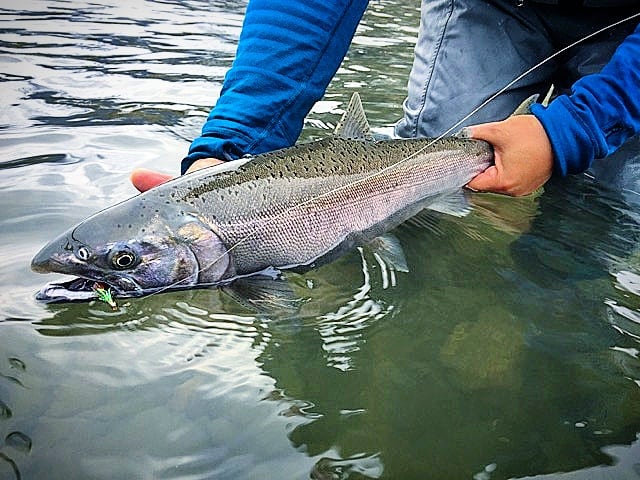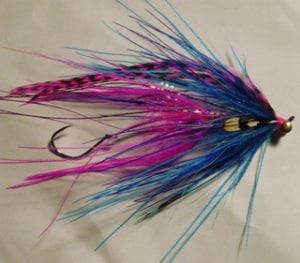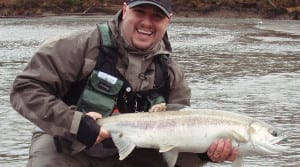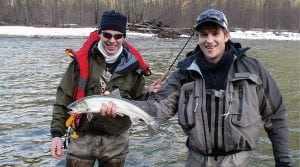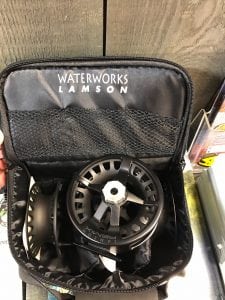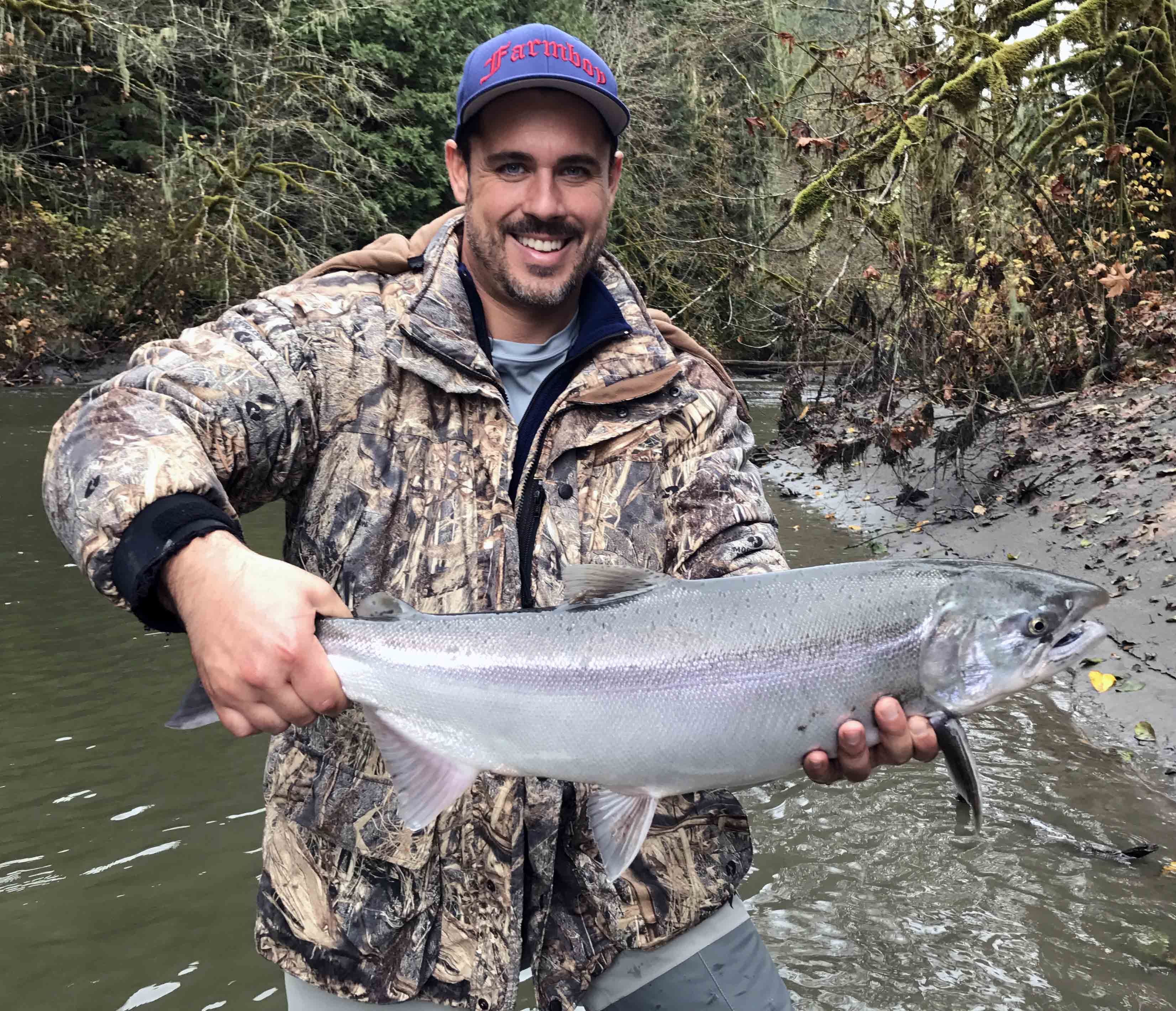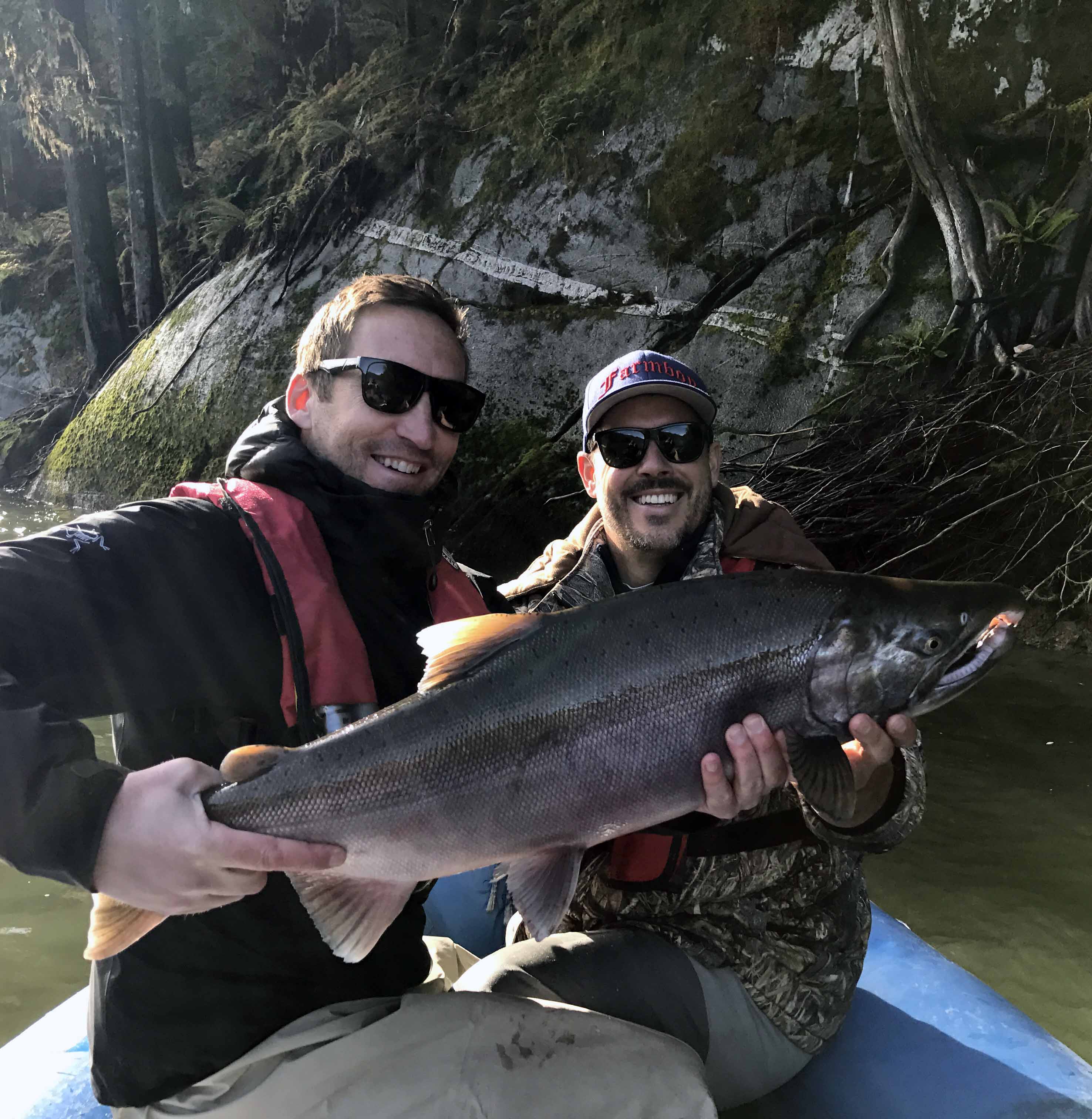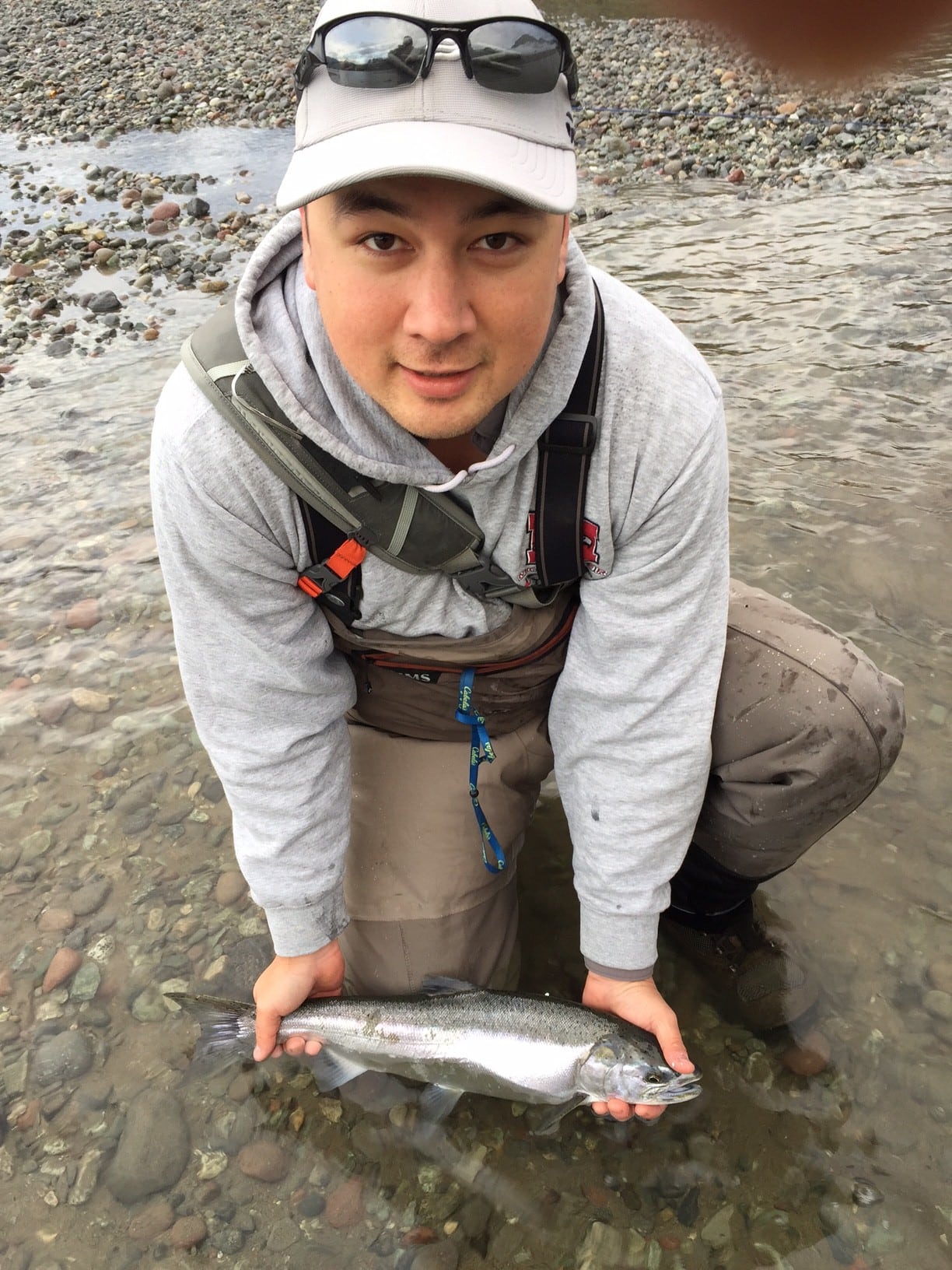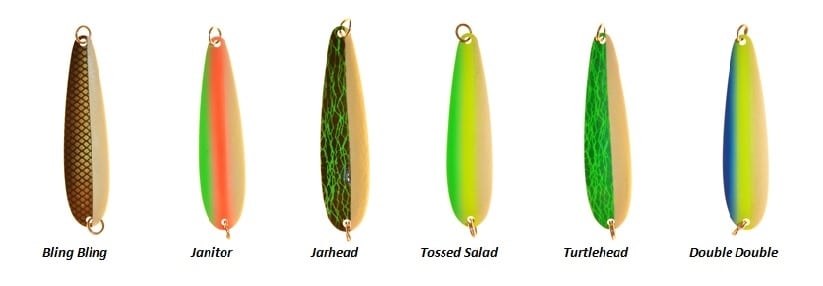OUTLOOK
Who is doing the weather reports lately? Every week I keep seeing 50+ mm reports and though we have seen a ton of rain the weatherman has been off as often as he has got it right.
It has made it very hard to predict when to fish. With reports being all over the map we have been out when the rain was supposedly not going to be an issue only to find flood conditions and the exact same week cancelled outings because of forecasted floods, only to find that rivers have been in shape.
Welcome to fall salmon fishing. Our best advice, is to watch river levels, watch weather patterns, then as long as things are safe, go fishing. Even when conditions have been off we are seeing a very good chum salmon return and solid coho numbers so it is worth heading out.
This week we are hearing that things are slowing down a little out at the Vedder but there are still fresh fish for anglers who fish hard.
Harrison is still a little high but the Chehalis is a system that might be worth looking at this time of year. Check out Andre, Sam and Alex’s reports below for more details.
Jordan, Andre, Matt and Ryan were all out on the Squamish this week and when they could dodge the weather the fishing was excellent. With two distinct fisheries really fishing well right now we decided to divide this weekend report into an Upper River coho report and a Lower River chum Report. Andre and Jordan have some great details below.
On the product front we our introducing a new section to the report entitled Friday’s Feature Product. Each week we will provide detailed information on a great product(s) and offer it to our customers at a discounted price. Our first feature is the New Lamson Liquid and Remix fly reels.
Lastly Jason has another winter chinook report with more tip on how to make sure your boat is stored properly for the winter. Check it out at the end of the report.
Good Luck on the water!
SPECIAL EVENTS
STEELHEAD FLY TYING JAM SESSION
Mark your calendars! The famous Steelhead Fly Tying Jam Session will be back on Wednesday November 23, 2016! Along with some great in-store deals there will be a variety of expert tiers on hand to answer questions and teach some tricks of the trade! Keep an eye on your inbox next week for all of the details and be the first to reserve your spot at this sure to sell out event!
CLASSES AND COURSES
Fly Fishing For Salmon In Rivers
Fly fishing for salmon is one of the most exciting fisheries in the Lower Mainland. Let us teach you the techniques and the hot spots to catch salmon on the fly in our local rivers. In the 3hr evening seminar you will learn about rod, reel and line, sink tip, and fly selection. Then put the skills into practice during a fully guided day on the water where you will learn how to read water and swing the fly!
Seminar: Nov 7 Guided: Nov 13 (custom trip dates available)
Seminar Time: 6:30pm – 9:30pm
Seminar Only Cost: $45.00
Seminar & Guided Walk’n Wade Cost: $250.000 per angler, minimum of 2 anglers per guided day on the water.
Fly Fishing Egg Patterns
This course is designed to teach you the secrets to one of the most productive presentations in the BC fly fishermen’s arsenal; nymphing egg patterns. This deadly method can be used for different species of trout, char, and salmon. During a 3-hour evening seminar we will teach you key concepts, strategies, and gear that will give you a well-rounded foundation during the seminar portion of the class. Then you will put those skills into practice during a fully guided day on the water.
Seminar: Nov 14, 6:30PM – 9:30PM
Guided: Nov 19 or 20
Cost: $250.00 + GST
FRIDAY’S FEATURE PRODUCT
LAMSON LIQUID AND REMIX FLY REELS
This is a new section of the Friday Fishing Report entitled Friday’s Feature Product. Each week we will provide detailed information on a great product(s) and offer it to our customers at a discounted price.
This weeks feature products are the Lamson Liquid and Remix Fly Reels
Performance Meets Cost Effective Design
When we look at fly reels we talk a lot about the materials used in their construction. Cast aluminum has always been the best material for keeping a reel’s price down while providing a solid amount of durability. Machined aluminum bar stock reels are what most people turn to if they want unparalleled impact resistance and durability but this comes with a higher price tag.
Lamson has come up with a way to use both technologies to produce some of the best performing reels on the market at an exceptional value. Enter the Lamson Liquid and the Lamson Remix.
Lamson Liquid
The Liquid reels consist of a pressure cast aluminum frame and spool with a durable polyurethane finish. The result is a great looking reel with a durable coating. This reel also has some serious stopping power and features the same high end, sealed conical drag found in Lamson reels three times the price. A single reel sells for an incredible $135 CAD and we think you will have a hard time finding a better reel for the money when it comes to trout fishing and light salmon or saltwater use. For the lake fisherman who also wants extra spools, there is a great case pack that comes with 1 reel and 2 extra spools, and only costs $215 CAD!
• Pressure cast aluminum frame and spool with a durable polyurethane finish.
• The frame and spool feature full radiused compound curves with near zero-radius inside corners.
• Award winning sealed conical drag system.
• Built in the USA.
• A single reel sells for $135 LQ 2.0, $150 LQ 3.5, $175 LQ 4.0.
• A reel, 2 spools, and case sells for $215 for LQ 1.5 or LQ 2.0.
• 1.5 and 2.0 are great trout reels.
• 3.5 and 4.0 are great entry reels for salmon, steelhead, switch, Spey, bonefish, permit, tarpon.
Lamson Remix & Remix HD
The Remix is a great combination of machined bar stock aluminum durability and pressure cast aluminum technology. For this series of reels Lamson produces a tough, machined 6061 aluminum reel frame finished off with Type II anodizing for a very durable and scratch resistant coating. For the spool they use the same cast aluminum spool found in the Liquid reels. Structurally you can do things with casting that you can’t machine, such as full radiused compound curves, near zero-radius inside corners, and for precise fit and finish you can go back and machine the cast part in critical areas amplifying the best aspects of the process. To finish it off the reel has the signature Lamson sealed conical drag system. Then end result is a highly functional and durable reel at a competitive price. They also offer the Remix in an HD version, which features a full frame to capture line without failure, making it perfect for today’s modern, skinny running lines used in Spey fishing.
These reels start at $215 CAD for trout sizes and $255 CAD in the HD version for salmon, steelhead, and warm water species. Without a doubt, this is one of the best reels in the market at this price. You just won’t find this level of durability, drag, and fit and finish for $215 to $255.
Both the HD and the standard Remix reels also come in a case pack option which consists of 1 reel and 2 extra spools. These case options start at $300 CAD and are a great idea for the trout angler who employs a variety of different lines in his arsenal. It is also great news for the Spey angler that loves to experiment with different running lines, line styles, and grain weights.
Remix brings together the best of CNC machining and pressure cast technologies to deliver an unprecedented level of quality at a great price.
• CNC machined frame made out of 6061 bar stock aluminum delivers maximum structural rigidity and durability. Finished off with Type II anodizing for a very durable and scratch resistant coating.
• Pressure cast spool is lightweight, has a durable polyurethane finish, and features smooth, compound curves.
• Award winning sealed conical drag system.
• Built in the USA.
• A single reel sells for $215 RX 2.0, $255 RX 3.5 HD, $295 R 4.0 HD
• A reel, 2 spools, and a case sell for $300 RX 2.0
• 1.5 and 2.0 are great trout reels.
• 3.5 HD and 4.0 HD are “heavy duty” versions of the Remix and have a full cage specifically designed to capture line without failure making it a perfect switch, Spey, or boat reel.
• 3.5 HD and 4.0 HD are great choices for salmon, steelhead, switch, Spey, bonefish, permit, tarpon.
If you are looking for a great North American made reel but want the best bang for your buck, look no further than the Lamson Liquid and Remix.
ALL LAMSON AND LIQUID REELS ARE 10% OFF REGULAR CAD PRICES FROM NOV 4 TO NOV 11.
FRESHWATER FISHING REPORTS
Vedder River Fishing Report
With November now upon us, the fall salmon runs on the Vedder have now past their peak and will start to taper off as we move through this month. In saying that, there are still chrome coho to be caught and a good number of clean chum salmon too if you put in some time and brave the early morning chill. There have even been reports of a couple fresh Chinooks being landed too. We are expecting a good amount of rain to fall in the Valley in the coming days so watch the river levels; if it doesn’t blow out we could be in for some great fishing for fresh pushes of fish. A good number of fish have been taken on spoons lately such as the Gibbs Koho and Croc spoons as well as Vibrax Spinners, but pro-cured roe has traditionally done well at first light. If you want to tug on some hard fighting chum, try drifting a purple and chartreuse jig. Fly anglers focus on small flash flies and muddlers in slower pockets or frog water, but don’t be afraid to bust out a bigger popsicle pattern if the water gets murky after the rains.
Alex Au-Yeung
Capilano River Fishing Report
The Capilano has been fishing decently for coho salmon amidst the fluctuating water levels; many of the rainy days have brought the river to blown out conditions so try to avoid fishing it on these days if possible. It is best to wait until the water starts to recede, which is typically the day after a good downpour. The bait ban has now been lifted, so drifting some pro-cured roe will give you a good shot at a clean coho. Drifting Colorado Blades can also be effective and fly anglers can find success with flash flies and olive muddler minnows.
Good Luck,
Alex Au-Yeung
Squamish River Fishing Report (Upper River Edition)
With the weekend rain having raised water levels, I was a little nervous about my day on the water. Having seen the graph steadily rising, I waited until the morning to see the real-time water levels. Waking up early I checked the weather report. With it looking good and the water at a now ‘reasonable’ level, we headed up with anticipation. With the road to the upper areas having been recently closed due to roadwork, it had been quite a while since I ventured into the upper reaches. Finding a pullout, we geared up and strung up the rods to start our day. Hiking about, we came to a nice side channel with some ‘frog’ water- unfortunately no one was home. We kept walking and came to a nice run. We saw a few fish rolling so stopped to put a few casts in. I hooked into what would have been a nice fresh coho but it ran me way down river and into my backing before it jumped a couple times and broke me off. This was a good sign and start to the day. Continuing our hike we came to a nice bend with a small outlet creek. The water was tanky with a fishy colour to it, and we could see some fish rolling and milling about. Trying a variety of larger, heavily weighted patterns, we were only able to get a couple quick bites but no connections. Scaling down our flies was the key, as well as varying our retrieve.
One thing to keep in mind is to not change flies too quickly when fishing tanky ‘frog water’. Before changing flies, I always try different depths and counting down, as well as varying my retrieve. I did short quick strips, small slow strips, long slow strips, and long fast strips. Once I feel like I’ve truly fished a fly without a take, I then consider changing flies. Sometimes you already have the right fly on, but the fish want a different presentation. On this day, I had bites from fish on various patterns that were all on the smaller side, my fishing partner included, but presentation and location were the key. Keep this in mind before cycling through all your flies.
This area had quite a few fish showing themselves, but only a few were landed. Once we saw the rolls and boils slowing down, we decided to try a different spot. Once back at the car, we headed farther up the road only to discover another one of our spots was inaccessible. On the way there, we saw three bears- possibly a grizzly with two juveniles. I may be wrong, but I remember last year hearing of a grizzly in the upper reaches that came down from up top. I’ve seen many black bears before in the upper, and from across the river, this bear and her two young ones were much bigger. They had shoulders, big heads, and the way the moved was different than any black bears I’ve seen before. I understand there are brown black bears, but something about these three were different. Regardless of what kind they were, please remember to be safe and to always carry bear spray with you.
Having taken the time to get there, we decided to fish what water we could. Time to move again- this time a little lower. Again, this spot was also not reachable on foot, leaving us to fish the water in and around it, but not right where we wanted to. With no other fish seen, we packed it up and called it a day. This proved to be a wise decision as it started to pour on us as we were driving back down from the upper section.
If you have any questions on what patterns I used, materials used in my flies, or what my general set up consists up, come on by the shop and come see me. Myself, or any of us here at the shop can point you in the right direction for flies and gear, including sink tips, leaders, and flies.
Tight lines, and be safe.
Jordan Simpson
Squamish River Fishing Report (Lower River Edition)
I was guiding on the Squamish last weekend and it was in a beautiful shape both in levels and clarity. This year the section below the Mamquam River has widened and has a perfect flow with a descent stretch of water to fish. It is a perfect spot to swing a fly, as the fish are moving up. You want to start here first and if you miss a few coho that wave at you as they refuse your fly then you can run up to Judd road and try to intercept them once again and hopefully this time you are rewarded with a chrome beauty. The best flies to use are bright coloured popsicles, egg sucking leeches and Hobo speys in pink, purple and orange. Use a type 3 sink tip with 5 feet of 12 lb. maxima to achieve a full swing without any hang-ups and fish really close to shore without wading in too much. Check the levels as unlike the Harrison River the Squamish system rises and drops really fast. Chris Hadachi who was in the “Fly fishing for Salmon River” course caught this nice coho on the lower Squamish after his 5th cast.
Andre Stepanian
Harrison River Fishing Report
The river hasn’t been down since the last time I was there which was on October 10th. I talked to a customer of ours on the phone that lives on the Harrison River and he has been going crazy watching the river and not being able to fish it. As soon as it is on it’s way down the wet weather takes care of it’s decline and the YO-YO effect starts up again. I don’t know what to think anymore as this is the 3rd year that the river is a bust for walk and wade fishery. I will run to the river if one day the river comes back to 9.0 meters assuming it is before mid November. For those of you that have a boat hopefully you are getting out there and are able to fish whether it is good or not.
Happy fishing,
Andre Stepanian
Chehalis River Fishing Report
The Chehalis River is another option for the fall salmon angler. Success is dictated by the water levels, it doesn’t have a graph like the Vedder/Chilliwack that makes hitting it right tough. Fishing it after a good rain will yield the best results. Short floating roe, casting spoons, and twitching jigs will give you the best chance of hooking up. This river can see a later run of coho and depending on the year you may get a couple chromers into December.
Sam Graham
SALTWATER FISHING REPORTS
Vancouver Saltwater Fishing Report
We have been out on the water on a few charters this past week and have been catching a few winter chinook. As usual for these fish, they have been on the bottom, right where the herring are. We are often fishing in 150-250 feet of water so that means one rod per downrigger and 18 pound white glow cannonballs. These cannonballs keep your gear down deep during a fast troll and big tides. Productive flashers have been the Salty Dawg and Kinetic Series with a glow stripe. Good old green or chartreuse blades with silver tape on one side and glow on the other are good choices as well. We usually keep the bait in the freezer for winter chinook, as we prefer to fish spoons instead. We use a 5 to 6 foot leader from our flasher to a spoon that is 3.0 to 3.5 in size. Spoons are a good choice as they glow and that makes a big difference when you are fishing deep. You can also troll fast with spoons and that means covering lots of water, which is important in this fishery as you have to search for the fish. Some of the better glow spoons on the market are the Oki Titan series, the Pesca RSG series, the Gibbs G-Force series and the Silver Horde Kingfisher series. Choose one of these and if it has some glow paint and some green or blue on it, you are fishing the right ones. There seems to be good amounts of bait around, so that should keep the fish around for now and it looks promising for this upcoming winter season. We are already catching some nice fish and it is only November. If you haven’t tried winter chinook fishing, give us a call to book a trip. It is a lot of fun and a great way to enjoy the outdoors this time of year.
This week’s tip is downrigger readiness for winter chinook. A lot of anglers will have just finished off fishing shallow off the Fraser mouth for chinook in August and September. We typically fish 30-70 feet in this fishery and don’t think too much about our downriggers. When fishing for winter chinook we are deep and on the bottom. It is not uncommon to bounce your cannonball along the bottom from time to time using an 18-pound cannonball and 225 feet of cable. If you have any issues at all with your downrigger or cable, you will find out in a hurry and you can usually kiss a costly 18-pound white glow cannonball goodbye! So on your first trip this winter slowly payout almost all your cable while trolling out in the open deep water. Look for any nicks or kinks or damage that may cause it to fail. Keep an eye on the spool and stop when you get down to the last half dozen wraps, make note of what your counter says so you know how deep you can fish, then bring the cable back up and stack it evenly and tightly. If there are multiple people running the boat, say your fishing buddy who you share the boat with, make sure you do this as sometimes your good old pal breaks the cable mid season, puts another cannonball on, and calls it a day. You make think there is 250 feet on the spool only to find out there is 175 and you are on your way down to 200 feet to bounce bottom. Not only are you not going to catch any fish if you can’t get to the bottom but you might not notice how low the spool is and you lose everything! That has caused a few heated moments on many a dock over the years. So do some maintenance on your riggers this winter and then we will see you out there!
See you in the shop or on the water,
Jason Tonelli


